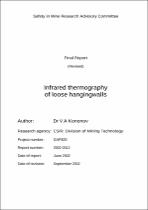JavaScript is disabled for your browser. Some features of this site may not work without it.
- ResearchSpace
- →
- Research Publications/Outputs
- →
- Conference Publications
- →
- View Item
| dc.contributor.author |
Kononov, VA

|
|
| dc.date.accessioned | 2008-01-22T09:28:41Z | |
| dc.date.available | 2008-01-22T09:28:41Z | |
| dc.date.issued | 2002-09 | |
| dc.identifier.citation | Kononov, VA. 2002. Infrared thermography of loose hangingwalls. Safety in Mines Research Advisory Committee, GAP 820, September, 2002, pp 1-102 | en |
| dc.identifier.uri | http://hdl.handle.net/10204/1882 | |
| dc.description.abstract | This project is the continuation of GAP706 “Pre-feasibility investigation of infrared thermography for the identification of loose hangingwall and impending falls of ground”. The main concept behind the infrared thermography method is that with an exposed hangingwall surface area, loose sections of ventilated rock should have a lower temperature than solid sections of ventilated rock because the former acts like cooling fins. The temperature gradient between loose and solid rock depends on the thermal conductivity of the rock, the ventilation conditions, the looseness of the rock and, to a lesser extent, the type of rock and age of mining. Such a gradient could be anything from a tenth of a degree to a few degrees Centigrade. | en |
| dc.language.iso | en | en |
| dc.subject | SIMRAC | en |
| dc.subject | GAP 820 | en |
| dc.subject | Infrared thermography | en |
| dc.subject | Loose hangingwall | en |
| dc.subject | Rocks | en |
| dc.title | Infrared thermography of loose hangingwalls | en |
| dc.type | Conference Presentation | en |
| dc.identifier.apacitation | Kononov, V. (2002). Infrared thermography of loose hangingwalls. http://hdl.handle.net/10204/1882 | en_ZA |
| dc.identifier.chicagocitation | Kononov, VA. "Infrared thermography of loose hangingwalls." (2002): http://hdl.handle.net/10204/1882 | en_ZA |
| dc.identifier.vancouvercitation | Kononov V, Infrared thermography of loose hangingwalls; 2002. http://hdl.handle.net/10204/1882 . | en_ZA |
| dc.identifier.ris | TY - Conference Presentation AU - Kononov, VA AB - This project is the continuation of GAP706 “Pre-feasibility investigation of infrared thermography for the identification of loose hangingwall and impending falls of ground”. The main concept behind the infrared thermography method is that with an exposed hangingwall surface area, loose sections of ventilated rock should have a lower temperature than solid sections of ventilated rock because the former acts like cooling fins. The temperature gradient between loose and solid rock depends on the thermal conductivity of the rock, the ventilation conditions, the looseness of the rock and, to a lesser extent, the type of rock and age of mining. Such a gradient could be anything from a tenth of a degree to a few degrees Centigrade. DA - 2002-09 DB - ResearchSpace DP - CSIR KW - SIMRAC KW - GAP 820 KW - Infrared thermography KW - Loose hangingwall KW - Rocks LK - https://researchspace.csir.co.za PY - 2002 T1 - Infrared thermography of loose hangingwalls TI - Infrared thermography of loose hangingwalls UR - http://hdl.handle.net/10204/1882 ER - | en_ZA |






